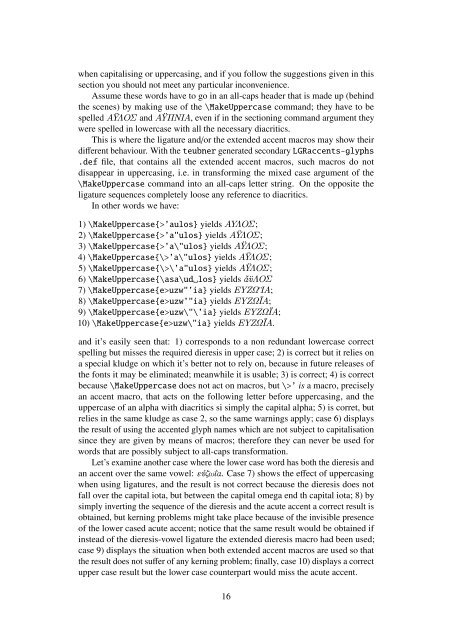teubner-doc.pdf.
teubner-doc.pdf.
teubner-doc.pdf.
Create successful ePaper yourself
Turn your PDF publications into a flip-book with our unique Google optimized e-Paper software.
when capitalising or uppercasing, and if you follow the suggestions given in thissection you should not meet any particular inconvenience.Assume these words have to go in an all-caps header that is made up (behindthe scenes) by making use of the \MakeUppercase command; they have to bespelled ΑΫΛΟΣ and ΑΫΠΝΙΑ, even if in the sectioning command argument theywere spelled in lowercase with all the necessary diacritics.This is where the ligature and/or the extended accent macros may show theirdifferent behaviour. With the <strong>teubner</strong> generated secondary LGRaccents-glyphs.def file, that contains all the extended accent macros, such macros do notdisappear in uppercasing, i.e. in transforming the mixed case argument of the\MakeUppercase command into an all-caps letter string. On the opposite theligature sequences completely loose any reference to diacritics.In other words we have:1) \MakeUppercase{>’aulos} yields ΑΥΛΟΣ ;2) \MakeUppercase{>’a"ulos} yields ΑΫΛΟΣ ;3) \MakeUppercase{>’a\"ulos} yields ΑΫΛΟΣ ;4) \MakeUppercase{\>’a\"ulos} yields ΑΫΛΟΣ ;5) \MakeUppercase{\>\’a"ulos} yields ΑΫΛΟΣ ;6) \MakeUppercase{\asa\ud␣los} yields ἄϋΛΟΣ7) \MakeUppercase{e>uzw"’ia} yields ΕΥΖΩ¨ΙΑ;8) \MakeUppercase{e>uzw’"ia} yields ΕΥΖΩΪΑ;9) \MakeUppercase{e>uzw\"\’ia} yields ΕΥΖΩΪΑ;10) \MakeUppercase{e>uzw\"ia} yields ΕΥΖΩΪΑ.and it’s easily seen that: 1) corresponds to a non redundant lowercase correctspelling but misses the required dieresis in upper case; 2) is correct but it relies ona special kludge on which it’s better not to rely on, because in future releases ofthe fonts it may be eliminated; meanwhile it is usable; 3) is correct; 4) is correctbecause \MakeUppercase does not act on macros, but \>’ is a macro, preciselyan accent macro, that acts on the following letter before uppercasing, and theuppercase of an alpha with diacritics si simply the capital alpha; 5) is corret, butrelies in the same kludge as case 2, so the same warnings apply; case 6) displaysthe result of using the accented glyph names which are not subject to capitalisationsince they are given by means of macros; therefore they can never be used forwords that are possibly subject to all-caps transformation.Let’s examine another case where the lower case word has both the dieresis andan accent over the same vowel: εὐζωΐα. Case 7) shows the effect of uppercasingwhen using ligatures, and the result is not correct because the dieresis does notfall over the capital iota, but between the capital omega end th capital iota; 8) bysimply inverting the sequence of the dieresis and the acute accent a correct result isobtained, but kerning problems might take place because of the invisible presenceof the lower cased acute accent; notice that the same result would be obtained ifinstead of the dieresis-vowel ligature the extended dieresis macro had been used;case 9) displays the situation when both extended accent macros are used so thatthe result does not suffer of any kerning problem; finally, case 10) displays a correctupper case result but the lower case counterpart would miss the acute accent.16
















